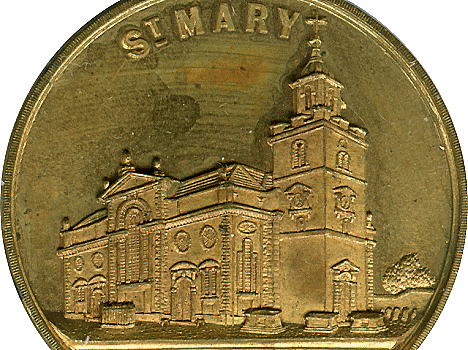Charity Tokens

Thomas Dickinson, by his will dated the 9th October 1848, and proved on the 14th January 1852, bequeathed to the rector of the parish of St. Mary, Whitechapel £4000 Consols in trust, the Interest to be used for the purchase of bread, coal and potatoes, at such times and in such proportions as the rector and trustees should deem appropriate. And he directed that the same should be divided equally during the winter months among 20 poor and deserving families who should be regular and constant attendants at Divine Service at the parish church of St. Mary. When the endowed charities of London were detailed in 1894 the income of the bequest from dividends was £110 for that year; and the distribution to poor families amounted to £110/1/0. The funds from this bequest still exist but have now been absorbed into a general Charity Commissioners fund.
The terms of Thomas Dickinson’s will specified that the Income from the bequest should be used to purchase bread, potatoes and coal; and tokens exist that mention all three commodities. Another token, thinner and not mentioning a commodity, may be later.
All tokens have a view of the church on the obverse. This could have been based on a print published by J. Booth for the Architectural Series of London Churches, July 4th 1826. The only difference is that the token does not show the two human figures in the print; otherwise both show the church from the identical viewpoint.


The church shown on the tokens was the second on the site. The first was built some time before 1286 and gave its name, “the White Chapel” to the district. The only people of note to have been buried in the churchyard were the executioner of Charles 1st, Richard Brandon (21/6/1649) and Admiral Sir Christopher Myngs, notorious for leading fleets of buccaneers and pirates against Spanish interests in the Caribbean (13/6/1666). When, after the restoration of Charles 2nd, the puritan rector was deprived of his living, virtually the whole congregation left and set up a meeting house nearby. In consequence the church fell into disrepair and was demolished and rebuilt in 1673. This is the building shown on the tokens. The church was again demolished and rebuilt in 1875, this time in gothic style. Unfortunately it was burned to the ground in 1880, but rebuilt in the same style in 1882; only to suffer the same fate during World War 2. It was never rebuilt: but the churchyard remains as a public open space alongside the main A11 road, just beyond the City boundary.
The tokens must, therefore, have been issued between 1852 and 1875. Their purpose is clear, but who made them and how many were issued is unknown. It is assumed that the charity was disbursed in the form of tokens to prevent the money being spent on beer or some other non-approved commodity. Presumably the tokens would only be exchanged for bread etc. by local shopkeepers, who would then exchange them for cash at the church.